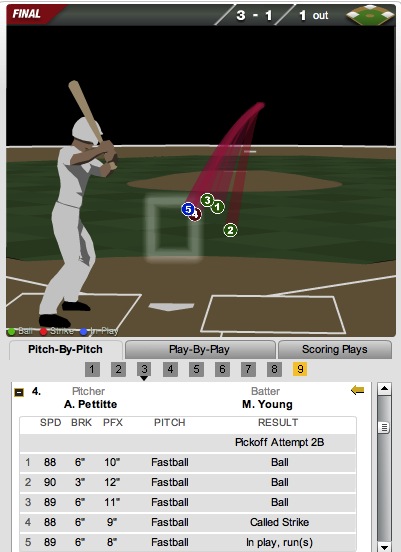For seven innings yesterday, Andy Pettitte held the Rangers in check. He used both his curveball and his cutter equally, mixing in the changeup five times. I’m still amazed that Pettitte continues using his fastball as often as he does. He threw 53 four-seamers to go along with 17 two-seamers, and even though he topped out at 90 according to the PitchFX gun the Rangers hitters still couldn’t do much with it.
Pettitte’s only blemishes came in the third inning, when a leadoff single opened an opportunity for the Rangers. As I mentioned in the recap, Elvis Andrus drove in a runner from second on what appeared to be a good pitch. The next batter, Michael Young, followed with an RBI of his own. Yet I couldn’t help notice something peculiar about Young’s at-bat: Pettitte used his fastball exclusively.
By reputation, Young kills fastballs. For a bit of statistical proof, if you look at his pitch type values at FanGraphs, you’ll see that he consistently rates very high. Why, then, would Pettitte deal Young a steady diet of fastballs? After the game he admitted that his mechanics didn’t feel right during the first five innings, so perhaps he stuck with the fastball in order to get everything back into working order. I think, though, that there’s a more likely explanation.
To that point in the series Young was 4 for 8. All four hits were singles, but with the relatively quick Andrus on second a single would have been all the Rangers needed to take the lead. Josh Hamitlon was due up after Young, and he presented a better match-up for many reasons. Not only would that be a lefty-lefty match-up, but Hamilton had also gone hitless since his first at-bat on Friday evening. He didn’t look particularly strong during his at-bat in the first, and I’m sure Pettitte would have much rather faced him than Young.
To that end, here’s the Gameday chart of the at-bat.

Five fastballs, all away. Even on a 3-0 count Pettitte still tried to catch the corner rather than throwing one over. This makes me think the strategy was to just keep the ball away from his wheelhouse, get him to chase if possible, but accept the walk if it comes to that. On the at-bat’s ultimate pitch, it appears Pettitte just missed his spot. The ball caught a bit too much of the plate, and Young did what he could with it.
That pitch was Pettitte’s only real mistake of the afternoon. Maybe the changeup he threw to Matt Treanor three batters earlier didn’t get inside enough, but that was just a single. The double to Andrus looked like a good enough pitch, but went for an RBI double anyway. To Young, though, that last pitch looked like it was supposed to end up a bit more outside, perhaps too far outside. That would have put runners on first and second for the slumping Hamilton. Of course, Hamilton hit the ball well, and would have had an RBI himself had Teixeira not made a leaping stab at a liner destined for right field. I do wonder, though, how differently the at-bat would have gone had Pettitte known that a ground ball would have ended the inning without another run scoring.
This actually makes me appreciate Pettitte’s start that much more. He ran into trouble in the third, and even though he wasn’t feeling 100 percent, he still stuck to his plan. He got a bit unlucky when he missed with a hittable fastball, but he also recovered that luck when Teixeira snagged Hamilton’s liner. This had the potential to be a big inning for the Rangers, but Pettitte limited the damage. A situation like this is one of the many reasons that the Yankees continue bringing him back every year.
Leave a Reply
You must be logged in to post a comment.